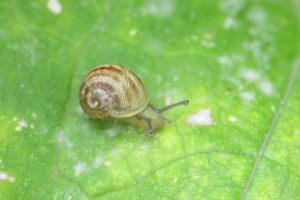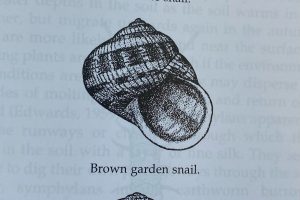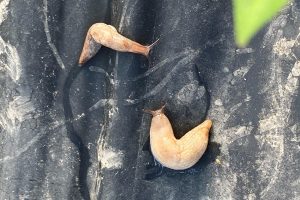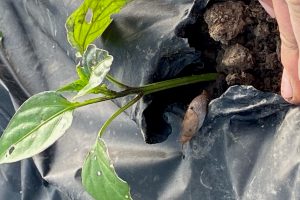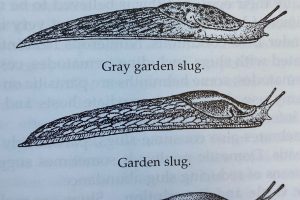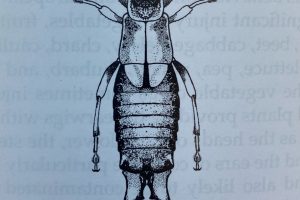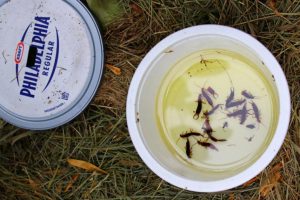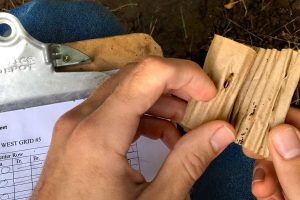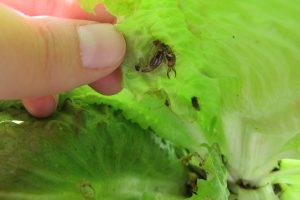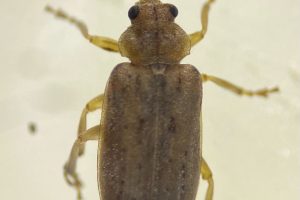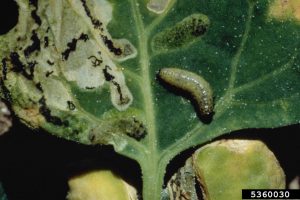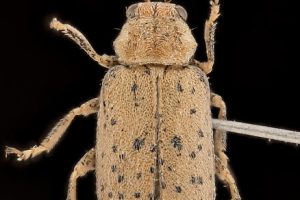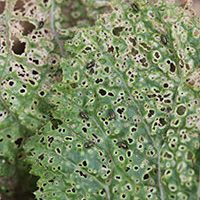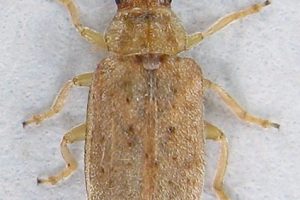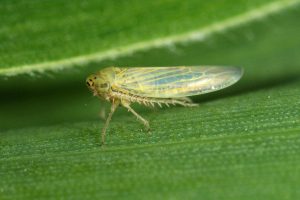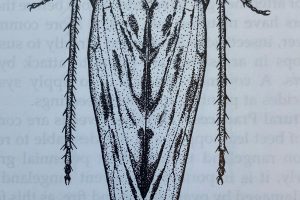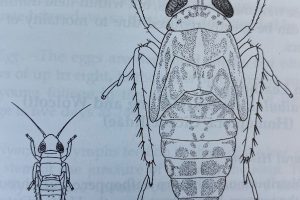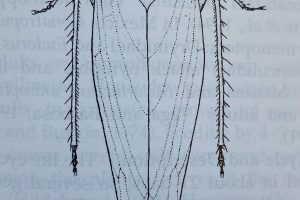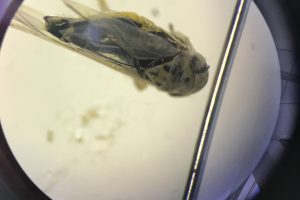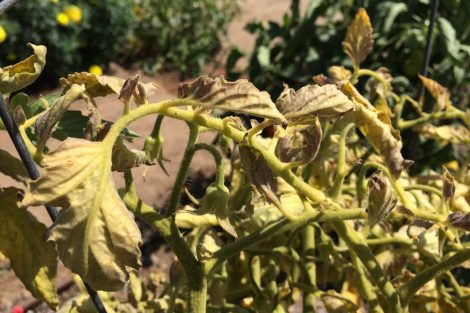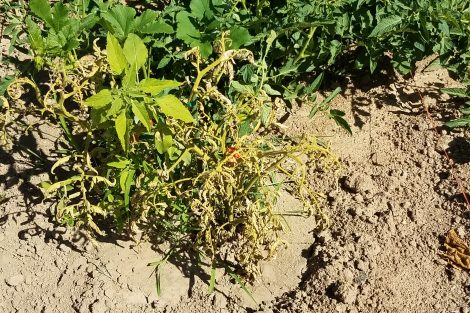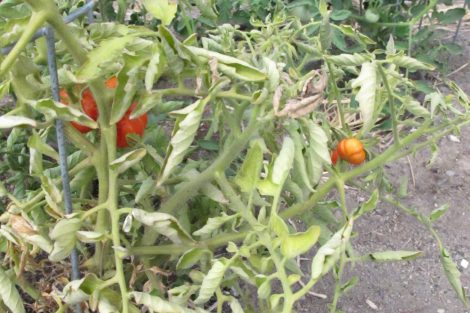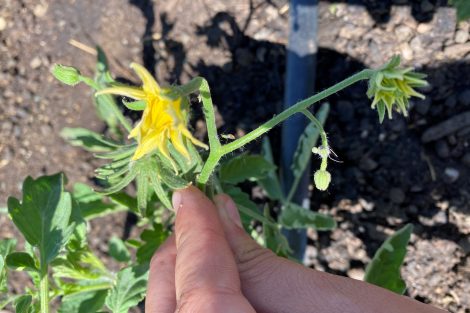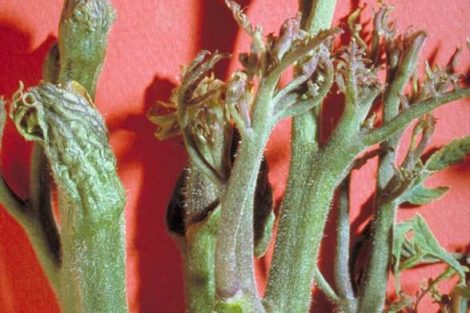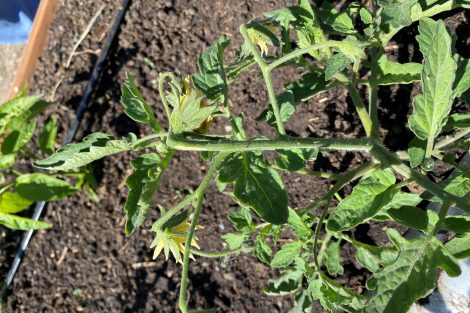In this Issue:
- Slugs/Snails
- European Earwigs
- Monoxia spp. Beetles
- Beet Leafhoppers
- Beet Curly Top Virus on Tomatoes
- Tomato Big Bud
SLUGS AND SNAILS
Occurrence: Active Now | Found at night or dark, cloudy days. During the heat of the day, they seek shelter under plants, rocks, wood, or compost piles. Require moisture
Description: Slugs and snails are both gastropods (a class of mollusks) that can be found throughout Utah. These creatures are hermaphrodites, meaning they are not male and female but all are capable of reproducing. They can lay multiple clusters of eggs throughout the growing season. These resemble small, white pearls about 1/8 inch in diameter. Depending on the species, there are 3 to 40 eggs in each cluster. Slugs and snails have similar characteristics except snails have an external, spiral shell. Both glide with a long, flat, muscular organ called a foot. Mucus or slime secreted by the foot aids in locomotion and dries to form a shiny white silvery trail, indicating that the pests are present.
Slugs and snails feed on a wide variety of living plants, fungi, and decaying plant materials.
They are particularly damaging to new seedlings and maturing vegetables or fruits that touch the soil.
They chew irregular holes that have smooth edges in leaves. They eat flowers and clip off small plants and plant parts. They damage strawberries, tomatoes, basil, lettuce, beans, cabbage, and many other vegetables.
Management:
- Water management is critical. Stretch irrigation intervals as long as possible and avoid watering in protected hiding areas if there are no plants there. Drip irrigation is one way of reducing the available moisture and can also help reduce problems with these pests.
- Slugs and snails avoid irritating barriers. Numerous barriers are recommended but barriers only work if slugs and snails have other desirable places to feed or hide. Mesh copper screens or sheeting 8 inches wide make effective barriers.
- Traps are an effective method of controlling pests.
- Place bait stations in strategic spots which will be more efficient and effective since slugs and snails are attracted to bait several feet away.
- Natural enemies, including geese, ducks, and other birds, seek out and destroy slugs and snails.
Examples of Slug and Snail Pesticide Products
| Iron Phosphate 1.00 % | BioAdvance Snail and Slug Killer Bait |
| Iron Phosphate 1.00 % | BioAdvance Natria Snail & Slug Killer Bait |
| Iron Phosphate 1.00% | Bonide Slug Magic Pellets |
| Metaldehyde 2% Carbaryl 5% | Cooke Pest Granules |
| Metaldehyde 3.25% | Corry’s Slug and Snail Death |
| Metaldehyde 3.25% | Corry’s Slug & Snail Pellets |
| Metaldehyde 4% | Corry’s Slug & Snail Liquid |
| Metaldehyde 4% | Deadline Raintough™ Slug & Snail Killer |
| Metaldehyde 4% | Deadline Force ll Slug & Snail Killer |
| Metaldehyde 3.25% | Hi-Yield Improved Slug Snail Bait |
| Metaldehyde 3.25% | Lilly Miller Snail & Slug Mini Pellets |
| Metaldehyde 2% Carbaryl 5% | Lilly Miller Slug, Snail & Insect Killer Bait |
| Metaldehyde 2% Carbaryl 5% | Lilly Miller Go-West Meal |
| Metaldehyde 1.5% | Lilly Miller Snail & Slug Spray |
| Metaldehyde 3.25% | Lilly Miller Slug and Snail Bait |
| Iron Phosphate 0.97% Spinosad 0.07 % | Monterey Sluggo Plus Insect, Slug & Snail Pellets |
| Iron Phosphate 1.00% | Monterey Sluggo |
| Plant Oils and Others | Monterey All Natural Snail & Slug Spray RTU |
| Silicon Dioxide, 85 % Diatomaceous Earth | Natural Guard Crawling Insect Control & Slug Killer |
| Metaldehyde 2% Carbaryl 5% | Ortho Bug-Geta Snail & Slug Killer |
| Metaldehyde 3.25% | Ortho Bug-Geta Snail & Slug Killer |
| Iron Phosphate 1.00% | Ortho Elementals Slug & Snail Killer |
EUROPEAN EARWIGS
Occurrence: Active Now | Nymphs and Adults are being seen and reported in agricultural and home landscape settings.
Description: Adult earwigs have an Elongate brown body with a red-brown head; 1/2 to 5/8 inch long. A prominent pair of “pinchers” (cerci) on the rear of the body; female cerci are straight while those of males are strongly curved (Fig. 3) for grasping females during mating. They hide in dark, tight, and moist places during the daytime; pheromones from frass (feces) and cuticular hydrocarbons (exoskeleton chemicals) attract earwigs to congregate. Nymphs have a similar appearance to adults, just smaller.
In the western U.S., the European earwig has two or more generations per year, and populations tend to build to their highest densities in mid to late summer. Adults overwinter in the soil as brooding pairs or above ground in aggregations.
The diverse diet of earwigs includes primitive plants (mosses, lichens, and algae), vascular plants, fungal spores, small invertebrate animals, and decaying organic matter. As opportunistic predators, they provide a benefit by preying upon plant pests such as aphids, scales, caterpillars, maggots, and mites. In contrast, their herbivorous eating behavior makes them a common pest in agricultural crops, home gardens, and landscapes; they often require intervention to reduce their damage to plants.
Management: A simple corrugated cardboard trap is an effective monitoring tool. Earwigs are active at night and seek refuge in cardboard traps during the daytime.
- Earwigs are also attracted to containers with smelly oils, such as fish or clam oil, or bacon grease. Punch holes in the lid and top sides of a plastic yogurt or sour cream container, and bury the bottom in a garden or flower bed where earwigs are causing plant damage. Check the traps several times per week, dispose of the earwigs, and replenish with fresh bait.
- Earwigs are weak fliers and primarily disperse by crawling. Place a band of sticky adhesives, such as a tangle trap, around a tree trunk or plant stem to exclude them. Apply the adhesive to a surface such as duct tape to protect the plant.
- Reduce or remove nesting and hiding places. Earwigs seek refuge in dark areas during the day. Weeds, plant debris, and volunteer corn plants should be kept clear from fields, especially in the spring.
Insecticides should be applied in the late evening just before earwigs come out to feed. Target sites where earwigs congregate (sites where females brood their young), and on plants when the injury appears.
Examples of Active Ingredients Available for Earwig Control at Home
diatomaceous earth, pyrethrin, carbaryl, azadirachtin, novaluron, pyriproxyfen, spinosad, spinetoram, diazinon, malathion, bifenthrin, cyfluthrin, cypermethrin, deltamethrin, lambda-cyhaolothrin, and permethrin
MONOXIA SPP. LEAF BEETLES
Occurrence: Active Now | Overwintering adults emerge as temperatures heat up. They have been seen and reported causing extensive feeding damage to vegetable starts.
Description: The genus Menoxia is a group of “leaf beetles” within the family Chrysomelidae. Adult Monoxia beetles average around 5mm in length. Most species are a subtle tan/brown color with some markings. These species also have a velvety appearance along with a segmented antenna. Like other leaf beetles, they are fully herbivorous and (both adult and larva) feed on plant tissue.
Similar to other leaf beetles, there tend to be one generation per year in Utah. Menoxia spp. overwinter as adults and emerge as the temperatures heat up. During this time, they will fly various distances and begin mating. In Utah, the first egg hatch is expected the first week of May, and peak egg hatch is during the last week of May. Newly hatched larvae begin feeding on the upper leaf surface. Larvae feed and grow for about 12-20 days while going through four instars. Larvae drop to the ground and burrow into the soil to pupate. Adults emerge from the pupal cases in about 10-21 days. The total development time from egg to adult is about 6 weeks depending on food quality and temperature.
Management: Vegetable crops grown near small grain fields or other rangeland may be more susceptible to feeding damage.
- Menoxia beetle adults prefer to colonize thin, weak plants, so promote healthy vegetable transplant growth to discourage migrating adults.
- Avoid late planting in the spring as the adults prefer younger growth. Early-planted gardens and farms are not as attractive to migrating adults.
If the pest pressure is intense and causing serious damage to the crops and there’s economic loss. Pesticide control may be necessary.
Examples of Home-Use Products for Leaf Beetle Control (READ LABEL to Verify Specific Crop Use)
| carbaryl | Garden Tech Sevin 5% Dust Bug Killer |
| malathion | Spectracide Malathion, Ortho Malathion |
| cyfluthrin | BioAdvanced Vegetable & Garden Insect Spray |
| permethrin | Bonide Eight Garden Dust |
| pyrethrins | Monterey Bug Buster-OOB; Worry Free Insecticide and MiticideB |
| zeta-cypermethrin | GardenTech Sevin |
| pyrethrins + canola oil | Espoma Insect ControlB; Monterey Take Down Garden SprayB |
| pyrethrins + potassium salts of fatty acids (insecticidal soap) | Safer Brand Tomato & Vegetable Insect KillerOB |
| pyrethrins + sulfur | Bonide Tomato and Vegetable 3 in 1B; Natria Insect Disease & Mite ControlB; Ortho Insect Mite & Disease 3 in 1B |
O=Organic, B=Biopesticide
BEET LEAFHOPPERS
Occurrence: Active Now | Tomato Big Bud and Beet Curly Top Virus have been reported and confirmed this season (both diseases vectored by the Beet Leafhopper)
Description: Adults are 3 mm long, and nymphs and adults have wedge-shaped bodies varying in color from pale green, grey, or tan. Both life stages jump when disturbed. They are typically a problem in early summer when weeds begin to dry up during the first 6–8 weeks of planting. Beet leafhoppers can have multiple generations per growing season. They overwinter as adults on weeds in the mustard family in southern Utah and migrate north on spring wind currents. Direct feeding damage is not economically important on tomatoes; however, they can spread beet curly top virus and big bud, which can have serious economic impacts.
Management: Manage leafhoppers by excluding them with floating row covers. Shade tomato and pepper plans. Destroy and remove plant debris. Confuse leafhoppers by “hiding” susceptible plants among resistant plants.
BEET CURLY TOP VIRUS
Description: Beet curly top virus is vectored by the beet leafhopper (Circulifer tenellus). It is a concern during spring and summer. Beet leafhoppers acquire the virus when feeding on infected weeds or other plants and transmit it when feeding on healthy plants. The virus overwinters in living host plants. The severity of symptoms can vary from plant to plant, and outbreaks vary from year to year. Symptoms include small, twisted curled leaves, purple veins, downward curling petioles, stunted growth, yellowing, and death of mature leaves.
Management: There are no chemical control options for beet curly top virus, and insecticide applications directed at beet leafhoppers are ineffective. Exclude leafhoppers with floating row covers. Remove infected plants immediately upon detection.
TOMATO BIG BUD
Description: Tomato big bud is caused by the phytoplasma Candidatus phytoplasma sp. spread by beet leafhoppers (Circulifer tenellus). Symptoms include large, swollen green buds (fail to develop; do not set fruit), thick apical stems, and shortened internodes and distorted small leaves
Management: There are no chemical controls for big bud, and insecticide applications directed at beet leafhoppers are ineffective. Exclude leafhoppers with a floating row cover. Remove infected plants immediately upon detection.

